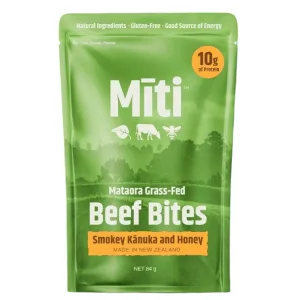 “All the science supported through the BPA has been instrumental in validating this proposition and positioning Mīti as a world-first in sustainable protein innovation” – Daniel Carson, founder, Mīti.
“All the science supported through the BPA has been instrumental in validating this proposition and positioning Mīti as a world-first in sustainable protein innovation” – Daniel Carson, founder, Mīti.
In a result that upends conventional thinking about sustainability, a world-first study has found that young dairy beef—when used as a meat ingredient—can have a lower carbon footprint than soy protein, while also delivering superior nutritional value.
The findings, emerging from a New Zealand-led scientific collaboration, could signal a major shift in how the global food industry views meat and sustainability.
The study, conducted by the New Zealand Institute for Bioeconomy Science, used a nutritional life cycle assessment (nLCA)—a new method that measures not just emissions, but the nutritional return on those emissions. Instead of comparing products by weight or calories, the nLCA looks at how much carbon is used to deliver essential nutrients like protein, iron, zinc and vitamins.
“This is world-first science,” says Daniel Carson, founder of Mīti, the sustainable protein start-up at the centre of the breakthrough. “It’s never been shown before that a meat product—especially beef—can outperform soy on both environmental impact and nutritional density.”
Daniel says that framing matters: “If you only measure carbon per kilogram, you miss the point. When you factor in nutrition, the playing field shifts. Meat isn’t just mass—it’s nourishment.”
Young dairy beef outperforms soy
The Mīti product uses young dairy beef, raised to 12 months, a strategy that tackles both the carbon and ethical concerns often levelled at the red meat and dairy sectors.
“Some of the carbon is allocated to the mother’s milk production that lowers the footprint of her calf’s beef,” explains Vincent Desaulniers Brousseau, the nLCA scientist behind the study. “But more importantly, beef delivers higher levels of iron, zinc and vitamins—and in forms that are more bioavailable than soy.”
Mr Desaulniers Brousseau also points out that soy-based foods often require additives and processing to make them palatable and marketable, which can raise their overall carbon footprint.
In contrast, the Mīti product is shelf-stable, lean, and rich in naturally occurring nutrients.
Solving a national problem with global potential
In New Zealand, 1.8 million bobby calves are sent to slaughter each year. Mīti’s solution transforms this waste stream into a high-value, exportable protein ingredient.
“This isn’t just about making a new food,” says Daniel. “It’s a systems change—a scalable model for solving a supply-side waste problem through demand-led innovation.”
Daniel points to recent comments by McDonald’s, which urged Kiwi beef producers to address the climate and bobby calf issues proactively before they impact the brand.
“Our product directly answers that call,” Carson says. “It’s a low-carbon, ethical beef ingredient for convenience foods—something that’s in global demand, particularly as food companies look to cut Scope 3 emissions in their supply chains.”
Recognition and validation
The innovation has not gone unnoticed. Mīti was recently awarded the 2025 Fieldays Early-Stage Innovation Award, judged by a panel of industry experts, and also took home the People’s Choice Award, voted by the public.
“The judges saw it for what it was—a whole systems approach,” says Carson. “They weren’t tied to the status quo, so they could evaluate the innovation objectively. It’s a huge deal that a food product took out that award.”
He says the People’s Choice Award offered commercial validation: “It shows that consumers are open to new kinds of meat products—especially ones that are both sustainable and nutrient-dense.”
Mīti is also a finalist in the New Zealand Food awards, with the winners to be announced on 16 October.
 BPA funding was game-changing
BPA funding was game-changing
Daniel credits much of the success to project funding from the BPA.
“The Mīti project has been a breakthrough for Alps2Ocean Foods, demonstrating that young dairy-derived beef can be transformed into a premium, shelf-stable, nutrient-dense food with a significantly lower on-farm carbon footprint than traditional beef,” he says.
“All the science supported through the BPA has been instrumental in validating this proposition and positioning Mīti as a world-first in sustainable protein innovation. The results have generated national media attention and helped elevate our public and industry profile.”
“Crucially, BPA funding enabled us to bring together a coalition of aligned partners across the red meat, science and sustainability value chains. This collaboration would not have been possible without the project support and has de-risked our next stage of scale-up, including manufacturing trials and investor engagement.”
“The success of this project proves that surplus non-replacement dairy calves can form the basis of a high-value circular economy export sector, unlocking a billion-dollar opportunity for New Zealand’s food and farming future.
“We greatly value the partnership and support of the BPA and look forward to working together again on future science-led innovations.”
A unique problem—and a unique advantage
Daniel says New Zealand has a global edge if it moves fast: “We have a problem that other countries don’t—millions of surplus calves—but that gives us a strategic opportunity. If we act as ‘NZ Inc’, we can offer something to the world that no one else can: a low-carbon, nutrient-rich beef ingredient, backed by science and ethics.”
With scale-up now in sight, Daniel sees Mīti as more than a product—it’s a model for how sustainability, innovation and economic value can align.
“This is what the future of food can look like,” he says. “But we have to be bold enough to lead it.”




Comments are closed.